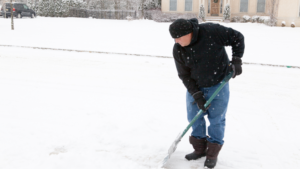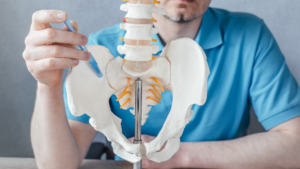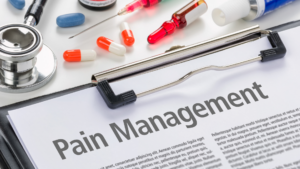Winter is a fantastic season with white sceneries and joyous outdoor activities from ice skating, skiing, and snowballing to snowmobiling. While these activities are fun, they can strain your muscles, leading to injuries that can aggregate your back pain, making it not the best season for folks with back pain.
Acute back soreness, stiff joints, and muscle strain are a few unfavorable side effects that might result or worsen from engaging in intense winter activities and chores. Nevertheless, below is everything you need to know about winter and back pain.

Winter Activities that Worsen Back Pain
Winter Activities that can Worsen Back pain
Different activities in winter increase your risk of back pain. Here are some of these activities:
- Cleaning Your House
Deep cleaning during winter includes bending, scrubbing, lifting, and scooping, which can strain your back. Sometimes, you experience a pulled muscle when cleaning and do not realize it. As you continue cleaning, the muscles worsen, causing back pain.
- Shoveling
If you are not careful when shoveling snow off your driveway or walkways, it could cause more back pain. Heavy lifting and bending required for this task could strain the back muscles and result in more back discomfort.
- Winter Sports
Winter sports such as snowboarding and skiing can cause back pain. The heavy boots and skis can pressure the lower back, causing pain. Falling while skiing or snowboarding can also stress the spine and soft tissues around it, leading to more back pain.
How Cold Weather and Winter Activities can Worsen Back Pain
The cold winter weather worsens back pain through a process known as vasoconstriction. This occurs when blood vessels narrow down and divert the extra blood to vital organs such as the lungs, heart, and brain. This results in less blood flow in the tendons, ligaments, muscles, and spine.
Low blood flow in the spine causes it to become stiff and tight. It strains your back and pulls on sensitive nerves causing back pain. Engaging in strenuous activities such as gardening and cleaning during this time causes more pressure in the back, worsening your back pain.
How You Can Prevent Back Pain
You can prevent winter back pain in various ways. Here are some tips:
- Wear the Right Gear
When you’re outside, dress in several layers, preferably in comfortable, move-friendly clothing and equipment. The appropriate shoes will help protect you against accidents that could cause or worsen your back discomfort, such as falls, slips, and other mishaps.
- A Healthy Diet
A balanced diet rich in calcium and healthy minerals helps prevent back pain. Calcium is not only good for the bones but also the spine. Minerals such as magnesium are good muscle relaxants that help prevent back pain during cold weather.
- Exercise Your Body
Staying physically active relaxes your muscles and increases mobility. Reduced stiffness allows easy movement and flexibility even during the winter, preventing back pain.
Treatment Options for Winter Back Pain
There are different treatment options for winter-related back pain. Here are some treatment options:
- Cold therapy
The use of cold therapy is a highly effective treatment for various physical ailments, including back pain, swelling, and muscle strains. There are many ways to apply it, such as ice massages, coolant sprays, ice packs, and ice baths. These are among the easiest, most effective treatments for reducing back pain and swelling.
- Heat therapy
Steamed towels, hot baths, and moist heating packs effectively reduce back pain. They offer temporary back relief by relieving tension and stiffness in the back.
- Interventional procedures and therapies
Pain procedures such as injections and medications are effective in treating back pain. Therapies such as acupuncture, chiropractic services, and physical therapy also help relieve back tension and treat back pain.
Get Treatment for Pain
If you are experiencing winter back pain, you should seek professional help as soon as possible before it worsens. At Progressive Pain Management, we focus on interventional effective pain procedures and advanced therapies to relieve back pain. Contact us today or fill out the form below to request an appointment.
Do you experience pain when you stand up out of a chair? Do you feel a dull or sharp pain in your lower back? You may be experiencing Sacroiliac Joint (SI) pain. This condition is very common – in fact, 15-30% of people who suffer from this kind of pain have joint problems they may not know about.
The good news is that numerous treatments are available to relieve you of this pain. But what is the SI Joint? And what causes this kind of pain?

Sacroiliac Joint Pain Causes and Treatment
What is the Sacroiliac Joint?
The sacroiliac joints are in your lower back, sitting on both sides of your spine. Their main job is to carry the weight of your upper body when you stand, walk, or shift your weight to your legs.
Although the pain typically starts in your lower back, if often moves to your buttocks, thighs, or upper back.
Causes of Sacroiliac Joint Pain
Because the SI joints carry the weight of your upper body, there are multiple causes for why you experience pain.
- Traumatic Injury – An injury like a fall or being in a car accident are common reasons for having SI joint pain. The force from this kind of injury strains the ligaments around the joint. If the ligaments aren’t treated correctly, they can tear and loosen the SI joints. When the joints move around too much from being loose, the SI joint can cause chronic pain.
- Arthritis – A specific kind of arthritis called ankylosing spondylitis affects the spine. It causes pain in your hips and buttocks.
- Pregnancy – Women have a higher chance of experiencing SI joint pain during pregnancy and childbirth. The same hormones that prepare the pelvis for childbirth loosen ligaments around the SI joint. This causes aches and pains that are common in pregnancy. The added weight during pregnancy also affects your SI joint.
Symptoms of Sacroiliac Joint Pain
SI joint pain can be hard to tell apart from other types of lower back pain. Because the pain can spread to your upper back, thighs, and buttocks, the pain could be confused with other conditions.
The main symptoms to look for are:
- Lower back pain
- Thigh pain
- Discomfort and pain after sitting
- Hip/Buttocks pain
It’s common to have after sitting for a long time, but SI joint pain also happens after running, climbing stairs, or taking large strides.
Diagnosing Sacroiliac Joint Pain
SI joint pain can disguise itself as different types of pain, like a herniated disc or facet joint arthritis. Doctors perform a series of tests to determine if you are suffering from SI Joint Syndrome. Pain during these tests helps the doctors learn more about where the pain is coming from.
Tests might include a variety of physical tests where the doctor will put stress and pressure on the joint to see if there is soreness or tenderness.
Doctors may also order diagnostic tests to confirm the source of your pain. These tests are often joint injections to confirm the root of your pain and imaging like X-Rays or MRIs to see a detailed image of soft tissue and bone.
Treatment Options for SI Joint Syndrome
Treatments for SI joint pain focus on reducing pain and restoring the full range of motion in the joint. Pain is treatment with non-surgical options, only using surgery if the pain persists.
Common treatments are:
- SI Joint Injections – Cortisone injections are used to reduce pain and calm inflammation. They can relieve pain for several weeks or months.
- Physical Therapy – Physical therapists create a specific program focused on your pain and discomfort. Their goal is to help you restore your quality of life, get back to doing your favorite activities, and manage your pain daily. Physical therapy trains your body to strengthen the ligaments and joints.
- Pelvic Brace – A supportive brace is helpful if your SI joint is loose. Wearing a brace that tight helps reduce inflammation and supports your painful joints.
- Heat or Ice – This at-home pain reliever is a great way to temporarily reduce pain, tensions, and inflammation to the joint.
Doctors may recommend multiple treatment options until they find a combination that works for your pain. Pain is different for everyone, so it’s important to find a doctor who creates an individualized treatment that fits your needs and lifestyle.
The team at Progressive Pain Management can help you reduce SI Joint Pain in a way that fits your lifestyle. Fill out the form below to get in touch with our team today.
There are a lot of options for treating pain without the use of narcotics. The opioid epidemic is spreading across the nation at frightening rates. Many state laws are cracking down on opioid prescriptions to prevent excessive prescribing.
However, this leaves many chronic pain patients feeling lost and confused about what options are available. In 2017, New Jersey passed a law that limits the initial opioid prescriptions to 5 days in an effort to reduce opioid misuse and addiction. Chronic pain is a legitimate medical concern.

Non-Opioid Treatments for Chronic Pain
Over-The-Counter Pain Relievers
Taking OTC pain relievers may not be the best way to manage your chronic pain, but will help reduce symptoms on a daily basis. Many doctors prescribe Non-Steroidal Anti-Inflammatory Drugs (NSAIDs) for those suffering from chronic headaches, osteoarthritis, or rheumatoid arthritis because these medications help fight pain and inflammation.
Physical Therapy
Patients who suffer from chronic pain are typically unable to maintain a healthy, active lifestyle. This leads to weakened joints and muscles. Physical therapy helps patients build up to their full potential by using low-intensity therapies like hydrotherapy and ultrasound. Once they get used to that routine and intensity, the focus can shift to more targeted exercises for their specific pain. Physical therapy encourages a higher quality of life and helps patients regain mobility.
Acupuncture
This ancient Chinese form of pain management is most often used to help treat back and neck pain, osteoarthritis, and chronic headaches. The needles stimulate a nerve, signaling the brain to release endorphins that act as a natural opioid. By stimulating the nerve that runs from your brain to your colon, inflammation will lower and often reduce the cause of pain.
High-Tech Methods for Managing Your Chronic Pain
With technology, new methods for treating pain are becoming increasingly popular with doctors and patients.
Radiofrequency Ablations
This process uses heat to reduce pain by eliminating communication to the brain. It’s common in patients who suffer from chronic pain in the lower back, neck, and joints. It provides immediate relief and gets the patient back to a restored quality of life in a shorter amount of time.
Spinal Cord Stimulation
Spinal cord stimulation hides the pain signal before it can reach the brain. A small device is surgically implanted under the skin and sends mild electrical currents to the spinal cord. Pain is reduced due to the stimulation modifying the pain signals and redirecting them away from your brain. Patients may sense a tingling sensation instead of pain.
Nerve Block Injections
With the help of an X-Ray, these injections can dampen or block the pain. Nerve blocks help the pain spread to other body parts, by minimizing the signals sent to the brain. Different types of nerve blocks depend on a patient’s pain. Injections can be used to treat painful conditions, determine the source of pain, or to predict the result of treatment.
Physicians are using these non-opioid treatments instead of writing prescriptions. Other therapies that don’t include medication like exercise therapy and cognitive-behavioral therapies (CBT) are gaining popularity. They focus on changing the patient’s attitude and awareness of their pain and teaching coping mechanisms to manage their pain better.
We Can Help
If you suffer from chronic pain, talk to your doctor about these alternative options for treating pain. Progressive Pain Management can help you find the relief you need. Fill out the form below to get started.

